Saturday, 27 December 2008
Sailing in unfamiliar waters
Here's another really fascinating position that arose because two players had reached unfamiliar waters.
Success in preparation!
Really interesting positions arose this morning against my fellow FICS membe in Caro-Kann Panov-Botvinnik. It is setup I have prepared for reasonably. Preparation is difficult as you don't want to go too deep in your own thought processess as it is impractical as there are so many other ways game could go. So my preparation is pretty limited but still I knew couple of concepts out of which I could find ideas to work with in playground.
Here it is.
Here it is.
Sunday, 21 December 2008
Lighter note
I had heavy day chesswise. Lot of dropping of pieces and lack of plans on board. I'm thinking maybe I'm taking in so many positions my mind is not able to settle as the subconscious is working constantly.
I have been quite dissapointed in my endgames and I've looked through my king and pawn endgames - and I was happy to see it paid off today for me!
Here's my endgame.
I have been quite dissapointed in my endgames and I've looked through my king and pawn endgames - and I was happy to see it paid off today for me!
Here's my endgame.
Thursday, 18 December 2008
At the thresholds of brilliancy.
I spent last couple of hours walking through one brilliant game by my fellow FICS member waparker. I hope I did some justice with my remarks.
Here's the game with analysis.
Here's the game with analysis.
Tuesday, 11 November 2008
Why not just give up??
I faced a lot of defeats sunday.
Here's key position from the 30 minute game against 1200 rating player:
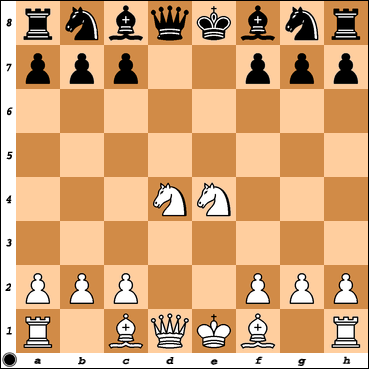
It is blacks turn to move and my opponent opens up his defense by 6...c5?? which Rybka thinks makes white win!
I found the correct 7.Bb5+! and my opponent correct Bd7!. But now I missed the mate threat after 8.Qe2!
Black cannot take with pawn ...cxd4?? because both 9.Nd6# and 9.Nf6#.
So 8...Be7 is correct. 9.Nf5 and white has resolved the threat against his knight.
So I played 8.Bxd7!? Qxd7
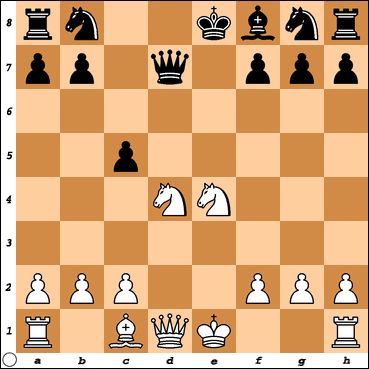
Here I can either create some threat so that i don't loose my knight or exchange queens. And I didn't found the threat which was: 9.Qe2!
Now black has to defend against the triple attack against king with 10.Nf6!
10...Qxd4 and white is winning: Nd6+! 11.Nxf7 and white has the rook whatever black does.
10....Be7 11.Nb5!
Anyway I played the next best thing 9.Nf3? Qxd1+ 10.Kxd1 Be7?! 11.Re1! Nf6?! 12:Nd6+!? and also black looses his castling rights. 12...Kf8 13.Nxb7 g6?? 14.Bh6+! Kg8
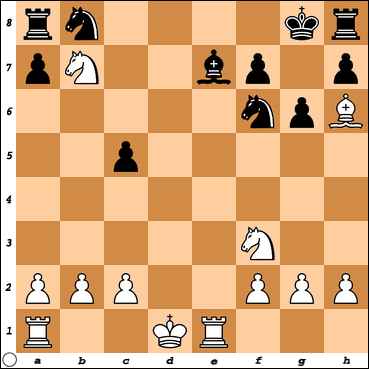
The 10...Be7 prooves to be fatal mistake. But I don't see it! 15.Rxe7
Instead I start to work on manual castling:
15.Ke2?? Bf8??
Rybka thinks I should just take: 16.Bxf8! Kxf8 17.Nxc5 and white is dominating the game with two beautiful pawns on b- and c-files.
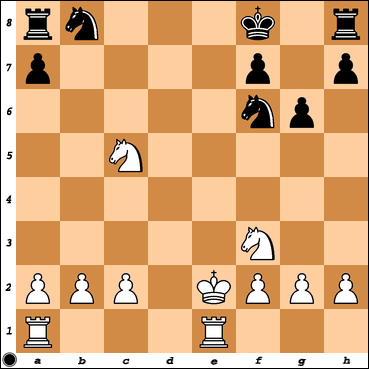
16.Bg5!? Kg7!? 17.Kf1 and my manual castle is ready.
17...Nbd7 18.Rad1 Rb8 threatening my knight.
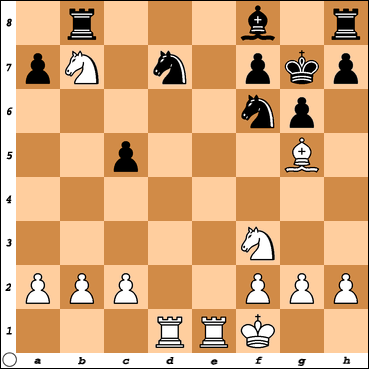
Rybka thinks I am still winning after 19.Nd6 when black can either take with bishop or just threaten bishop with ...h6.
Anyway I just took with bishop Bxf6+ and black should be ok if worse with Nxf6. But my opponent didn't see this but played the horrible 19...Kxf6?? 20.Rxd7+ c4 and I am totally winning.
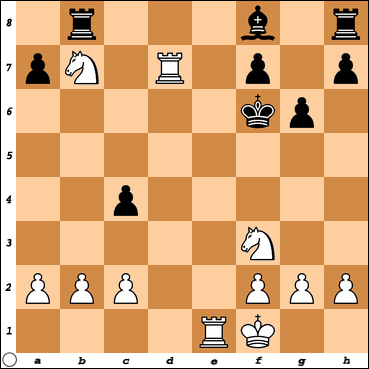
But wait a minute? I lost the game from this position.
Rybka likes 21.Nd8, 21.Ne5 the most.
21.Nd8! threatens mate in Rxf7#
So black has to exchange his rook for my knight 21....Rxd8 22.Rxd8
21.Ne5 and rook threatens to take on f7 so 21...Be7 22.Nc6 threatening to double rooks and take bishop at the same time Rexe7! so black exchanges knight with rook 22....Rxb7 23.Rxb7 threatening to double rooks and take bishop.
Anyway I play 21.Nd4 which is not loosing by any means. 21...Bb4 22.c3 Bf8 23.Nc6!? Rc8!?
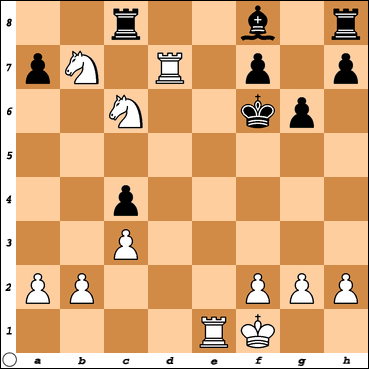
And here i would need some basic understanding how knights operate: 24.Ndb8! and knights support each other beautifully.
I play 24.Nxa7 which is loosing move either. 24...Ra8! and black screwed my knight to pawn.
25.Nd8 looks just fine but I play 25.Na5 Bc5! 26.N7c6 Rhc8?!
27.Re4 and white threatens to check king with Rf4+
27.b4? cxb3! 28.axb3! Bb6 29.Rd6+?! Kg7 30.Re5 and I thought I lost the game and resigned.
The strange thing is even I lost the totally dominating position I am still anything but lost!?
31.Red5 and if bishop takes ...Bxd6 32.Rxd6 black still has two beautiful passed pawns and two knights and rook against two rooks.
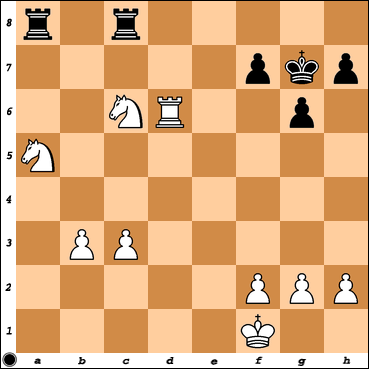
Weird resignation. I felt bad about how I handled position and just wanted to give it all up. This tells me as much as a person as chess player. Weird sensation to replay these events afterwards.
Here's key position from the 30 minute game against 1200 rating player:

It is blacks turn to move and my opponent opens up his defense by 6...c5?? which Rybka thinks makes white win!
I found the correct 7.Bb5+! and my opponent correct Bd7!. But now I missed the mate threat after 8.Qe2!
Black cannot take with pawn ...cxd4?? because both 9.Nd6# and 9.Nf6#.
So 8...Be7 is correct. 9.Nf5 and white has resolved the threat against his knight.
So I played 8.Bxd7!? Qxd7

Here I can either create some threat so that i don't loose my knight or exchange queens. And I didn't found the threat which was: 9.Qe2!
Now black has to defend against the triple attack against king with 10.Nf6!
10...Qxd4 and white is winning: Nd6+! 11.Nxf7 and white has the rook whatever black does.
10....Be7 11.Nb5!
Anyway I played the next best thing 9.Nf3? Qxd1+ 10.Kxd1 Be7?! 11.Re1! Nf6?! 12:Nd6+!? and also black looses his castling rights. 12...Kf8 13.Nxb7 g6?? 14.Bh6+! Kg8

The 10...Be7 prooves to be fatal mistake. But I don't see it! 15.Rxe7
Instead I start to work on manual castling:
15.Ke2?? Bf8??
Rybka thinks I should just take: 16.Bxf8! Kxf8 17.Nxc5 and white is dominating the game with two beautiful pawns on b- and c-files.

16.Bg5!? Kg7!? 17.Kf1 and my manual castle is ready.
17...Nbd7 18.Rad1 Rb8 threatening my knight.

Rybka thinks I am still winning after 19.Nd6 when black can either take with bishop or just threaten bishop with ...h6.
Anyway I just took with bishop Bxf6+ and black should be ok if worse with Nxf6. But my opponent didn't see this but played the horrible 19...Kxf6?? 20.Rxd7+ c4 and I am totally winning.

But wait a minute? I lost the game from this position.
Rybka likes 21.Nd8, 21.Ne5 the most.
21.Nd8! threatens mate in Rxf7#
So black has to exchange his rook for my knight 21....Rxd8 22.Rxd8
21.Ne5 and rook threatens to take on f7 so 21...Be7 22.Nc6 threatening to double rooks and take bishop at the same time Rexe7! so black exchanges knight with rook 22....Rxb7 23.Rxb7 threatening to double rooks and take bishop.
Anyway I play 21.Nd4 which is not loosing by any means. 21...Bb4 22.c3 Bf8 23.Nc6!? Rc8!?

And here i would need some basic understanding how knights operate: 24.Ndb8! and knights support each other beautifully.
I play 24.Nxa7 which is loosing move either. 24...Ra8! and black screwed my knight to pawn.
25.Nd8 looks just fine but I play 25.Na5 Bc5! 26.N7c6 Rhc8?!
27.Re4 and white threatens to check king with Rf4+
27.b4? cxb3! 28.axb3! Bb6 29.Rd6+?! Kg7 30.Re5 and I thought I lost the game and resigned.
The strange thing is even I lost the totally dominating position I am still anything but lost!?
31.Red5 and if bishop takes ...Bxd6 32.Rxd6 black still has two beautiful passed pawns and two knights and rook against two rooks.

Weird resignation. I felt bad about how I handled position and just wanted to give it all up. This tells me as much as a person as chess player. Weird sensation to replay these events afterwards.
Sunday, 2 November 2008
Speculation begins
I had some really interesting games against my fellow FICS member last night. I went to sleep early in the evening and woke up far too early and played some games.
The thing is I feel maybe I had prepared slightly more accurate opening repertory and ideas but my opponent is more accurate counting combinations and sees more deeply into the position than me. This made really interesting games when my opponent dares to make speculative maybe even dubious moves and finds way to resolve the problems that persue.
He has added me on his notify list and me him so it seems there is something challenging for both of us in our games together. So as usual when I am sleepy I just observe and I found him against another player on this position:
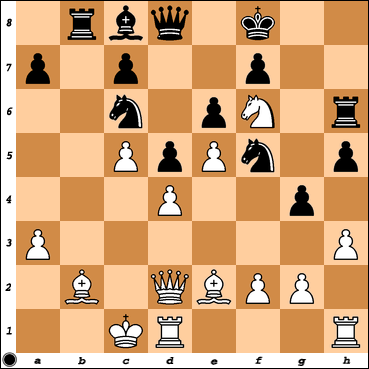
Knight and bishop have been exchanged and it is black to move. It is not a pattern I recognize from anywhere and some ideas spring to mind on what black should do but it seems they are all refuted. It is most fascinating. This kind of multiplexity is something my fellow member drives for. During some game he just stated he does not want to get rid of his pieces. I am not sure if this always makes him play sound but it sure makes interesting game. So what black should do?
White threatens hxg4 so something has to be done not to double threat 20.hxg4 when white either threatens to take the knight gxf5 or exchange rook for rook and knight ...hxg4 Rxg4 Nxh6 Qxh6+
So. 19...Rxf6! seems correct even it exchanges rook for knight. Now 20.exf6 Qxf6 seems yet still correct.
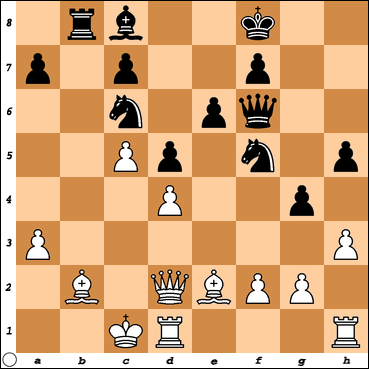
Black threatens to play g3 when the pull white had in the position is lost. It seems correct would have been: 21.hxg4! hxg4
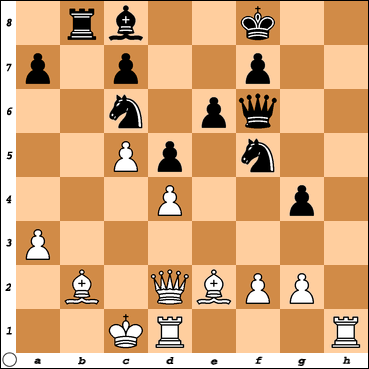
Now Rybka at depth of 18 gives two suggestions that both seem worth checking out: first: 22.Bxg4!? Ncdx4 23.Bxd4 Nxd4 24.Qxd4 e5 25.Qe3 Bxg4 26.Rxd5 Bf5 when position is simplified and white is simple rook better.
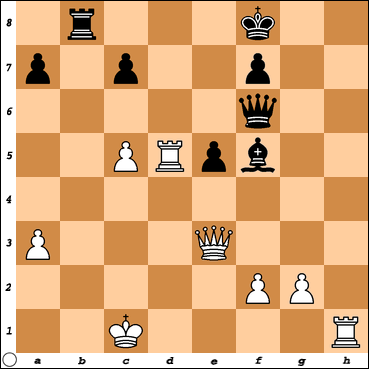
And then the move white on the actual played on move 21: Qf4!? Rxb2 23.Kxb2 Ncxd4 24.Rxd4 Bxd7 25.Bxg4 Qxd4+ 26.Qxd4 Nxd4
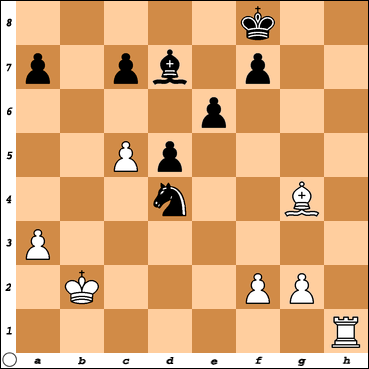
White is exchange better.
Anyway 21.Qf4? was played from being in winning position white has to face a bit better position for black.
Fascinating stuff both made some really dubious moves on the next few moves.
This kind of positions are not my turf but really fascinating stuff. And now in the middle of the night I complimented my fellow fics member on good game and we got into these interesting games I am willing to have a look at next posts or so.
The thing is I feel maybe I had prepared slightly more accurate opening repertory and ideas but my opponent is more accurate counting combinations and sees more deeply into the position than me. This made really interesting games when my opponent dares to make speculative maybe even dubious moves and finds way to resolve the problems that persue.
He has added me on his notify list and me him so it seems there is something challenging for both of us in our games together. So as usual when I am sleepy I just observe and I found him against another player on this position:

Knight and bishop have been exchanged and it is black to move. It is not a pattern I recognize from anywhere and some ideas spring to mind on what black should do but it seems they are all refuted. It is most fascinating. This kind of multiplexity is something my fellow member drives for. During some game he just stated he does not want to get rid of his pieces. I am not sure if this always makes him play sound but it sure makes interesting game. So what black should do?
White threatens hxg4 so something has to be done not to double threat 20.hxg4 when white either threatens to take the knight gxf5 or exchange rook for rook and knight ...hxg4 Rxg4 Nxh6 Qxh6+
So. 19...Rxf6! seems correct even it exchanges rook for knight. Now 20.exf6 Qxf6 seems yet still correct.

Black threatens to play g3 when the pull white had in the position is lost. It seems correct would have been: 21.hxg4! hxg4

Now Rybka at depth of 18 gives two suggestions that both seem worth checking out: first: 22.Bxg4!? Ncdx4 23.Bxd4 Nxd4 24.Qxd4 e5 25.Qe3 Bxg4 26.Rxd5 Bf5 when position is simplified and white is simple rook better.

And then the move white on the actual played on move 21: Qf4!? Rxb2 23.Kxb2 Ncxd4 24.Rxd4 Bxd7 25.Bxg4 Qxd4+ 26.Qxd4 Nxd4

White is exchange better.
Anyway 21.Qf4? was played from being in winning position white has to face a bit better position for black.
Fascinating stuff both made some really dubious moves on the next few moves.
This kind of positions are not my turf but really fascinating stuff. And now in the middle of the night I complimented my fellow fics member on good game and we got into these interesting games I am willing to have a look at next posts or so.
Tuesday, 28 October 2008
Position that makes me happy
Funny thing that I should feel relieved and happy about this position:
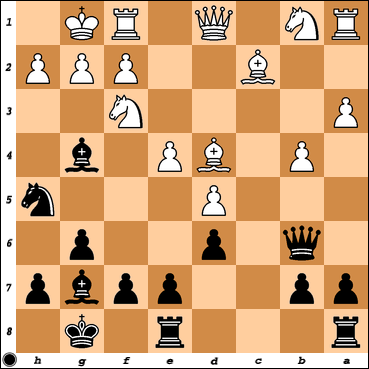
It's black to move and one move keeps position slightly better for black and every other move is loosing.
Bishop has forked my bishop and queen. That bishop is protected by white queen and white knight. My bishop on g4 is threatening white knight and my bishop and queen on g7 and b6 are threatening white bishop.
The funny thing is that I chose wrong move and I stll feel this way. Why do I feel good about this? It is because this is so typical - or preminiscent of the position that I have great difficulties in. And here I have it. This kind of multirelation understanding is very difficult for me.
Playing on FICS I get those comments of gloating on my bad moves and I am not able always to just ignore them. The reaction I am waiting for is that even I made bad move I am kind of respectable fellow chessplayer and not somebody that can be treated badly. I DO understand my limitations and problems but because I am not sure of myself I am still waiting for some assurance. Is it wrong to expect good manners on the net? I think it is a bit hopeless task: there are always people who do try to make me feel bad - this is what makes them tick and feel good about themselves.
Anyway.
The right move is 14...Bxf3!
This was 5 minute blitz game so I do not have eternity to think over is one explanation. But. I did spend only 5 seconds on thinking over. My opponent has still 4 minutes on the clock and I have around 3:20 minutes on mine. I seem to recollect that I wonderer a millisecond about Bxf3 and I thought white can just take my queen and be better.
This is very unsharp recollection of those five seconds.
But 15.Bxb6 is in fact bad move because after 15...Bxd1 16.Rxd1:
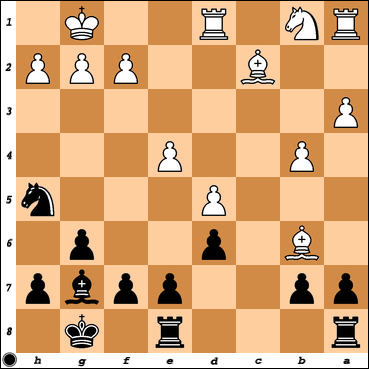
I have rook: Bxa1!
Can't white just save the rook by 16.Ra2?
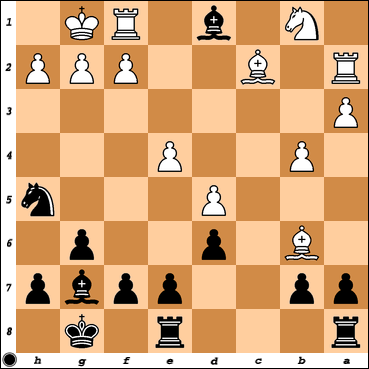
No.
After 16...Be2 and black threatens white rook. Interesting answer for white is 17.Ba4!? Bxf1 18.Kxf1 axb7 19.Bxe8 Rxe8
Can't white just refuse to give rook by 17.Re1?
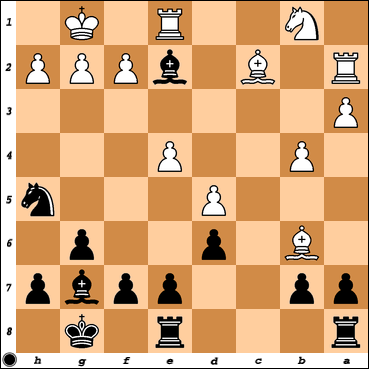
Well. No.
White moves bishop to c4 17....Bc4! and rook on a2 is totally trapped.
This is only one of the variations that is totally bad for white naturally. Right is 15.Qxf3 after which black can take back whites minor piece with either bishop or queen. But I never got to see this.
My mind went black and I took bishop on d4 and I lost one minor piece on the exchange of pieces. 14...Bxd4?? 15.Qxd4

It's black to move and one move keeps position slightly better for black and every other move is loosing.
Bishop has forked my bishop and queen. That bishop is protected by white queen and white knight. My bishop on g4 is threatening white knight and my bishop and queen on g7 and b6 are threatening white bishop.
The funny thing is that I chose wrong move and I stll feel this way. Why do I feel good about this? It is because this is so typical - or preminiscent of the position that I have great difficulties in. And here I have it. This kind of multirelation understanding is very difficult for me.
Playing on FICS I get those comments of gloating on my bad moves and I am not able always to just ignore them. The reaction I am waiting for is that even I made bad move I am kind of respectable fellow chessplayer and not somebody that can be treated badly. I DO understand my limitations and problems but because I am not sure of myself I am still waiting for some assurance. Is it wrong to expect good manners on the net? I think it is a bit hopeless task: there are always people who do try to make me feel bad - this is what makes them tick and feel good about themselves.
Anyway.
The right move is 14...Bxf3!
This was 5 minute blitz game so I do not have eternity to think over is one explanation. But. I did spend only 5 seconds on thinking over. My opponent has still 4 minutes on the clock and I have around 3:20 minutes on mine. I seem to recollect that I wonderer a millisecond about Bxf3 and I thought white can just take my queen and be better.
This is very unsharp recollection of those five seconds.
But 15.Bxb6 is in fact bad move because after 15...Bxd1 16.Rxd1:

I have rook: Bxa1!
Can't white just save the rook by 16.Ra2?

No.
After 16...Be2 and black threatens white rook. Interesting answer for white is 17.Ba4!? Bxf1 18.Kxf1 axb7 19.Bxe8 Rxe8
Can't white just refuse to give rook by 17.Re1?

Well. No.
White moves bishop to c4 17....Bc4! and rook on a2 is totally trapped.
This is only one of the variations that is totally bad for white naturally. Right is 15.Qxf3 after which black can take back whites minor piece with either bishop or queen. But I never got to see this.
My mind went black and I took bishop on d4 and I lost one minor piece on the exchange of pieces. 14...Bxd4?? 15.Qxd4
Monday, 29 September 2008
Once again
This position arose in the 25 minute blitz game in FICS yesterday against 100 hundred rating points lower player than me. I have drifted last days hanging my queen because I thought there was a pin when there de facto wasn't and so on. Hell, in one game I gave my queen just because I didn't notice it was there for the taking and so on.
But anyway even I lost it is always joy to find out afterwards that I had reached a winning or atleast promising position after 36. moves. When in game I made loosing move, there was much stronger move available.
Here's the position.
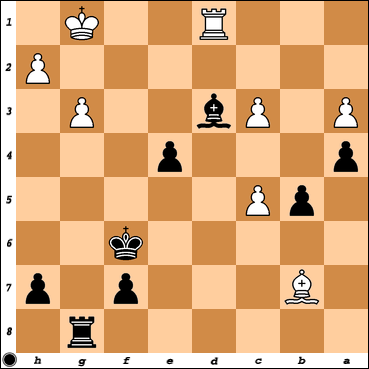
It is blacks turn to move.
The bad news is. White has a passed pawn on c5 and rook cannot move to c8 because of whites bishop. Black bishop is not able to stop it.
The fact that black king can stop the promotion is so much out of my head that I have spent this afternoon working out blacks best move without realising black can do for a while with moving the king!
After writing the chapter above I begun to wonder if this has to do with recognizing that the game has shifted from middlegame to endgame!? I'm not sure if this is important as good move is good always. But maybe it is in a sense that the concepts that mind should dwell are different. King becomes much more valuable piece than before and pawns become more important - maybe we are in thresholds of endgame in this position?
Anyway: the king move 37...Ke6!? is possible but the best move is simple 37...Rg5!
But anyway even I lost it is always joy to find out afterwards that I had reached a winning or atleast promising position after 36. moves. When in game I made loosing move, there was much stronger move available.
Here's the position.

It is blacks turn to move.
The bad news is. White has a passed pawn on c5 and rook cannot move to c8 because of whites bishop. Black bishop is not able to stop it.
The fact that black king can stop the promotion is so much out of my head that I have spent this afternoon working out blacks best move without realising black can do for a while with moving the king!
After writing the chapter above I begun to wonder if this has to do with recognizing that the game has shifted from middlegame to endgame!? I'm not sure if this is important as good move is good always. But maybe it is in a sense that the concepts that mind should dwell are different. King becomes much more valuable piece than before and pawns become more important - maybe we are in thresholds of endgame in this position?
Anyway: the king move 37...Ke6!? is possible but the best move is simple 37...Rg5!
Saturday, 27 September 2008
Mate in two
As the title goes. This is from a game this morning. Not bad game because there are solid choices among dubious ones all the way to the move 30 or so. And now everything was in its right place. It's whites move.
It's mate in two.
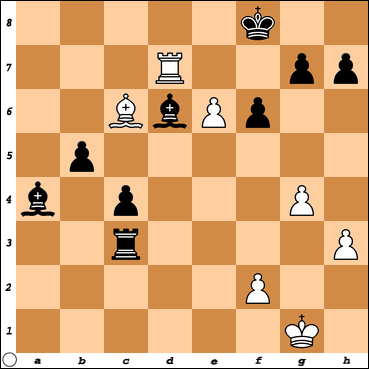
I missed it. Lately I have focused pretty much in the opening phase. I wish I get better seeing these kinds of positions clearly. I miscalculate combinations and my mind is not well set. This is what I would like to be better at - among basic pawn endgames, mates and so on.
It's mate in two.

I missed it. Lately I have focused pretty much in the opening phase. I wish I get better seeing these kinds of positions clearly. I miscalculate combinations and my mind is not well set. This is what I would like to be better at - among basic pawn endgames, mates and so on.
Friday, 30 May 2008
The time I outplayed Robert J. Fischer
This wednesday I found myself in the same position as Robert J. Fischer back in 1964 against Michel Tordion in simul game held in Quebec. What's peculiar is that it seems I made better decision on the position. It must be matter of wholelotta discussion and debate what you consider better but. Here we go.
Me - NN
Blitz 20 minutes
28.5.2008
1.e4 c5 2.Nf3 Nc6 6.3.d4 9.cxd4 4.Nxd4
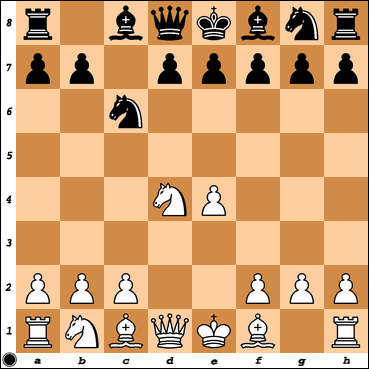
Here black has three standard approaches the Accelerated dragon 4...g6, the Sveshnikov variation which seems to be the main line 4...Nf6 5.Nc3 e5, 4...e6 that is the Taimanov Sicilian and the Kalishnikov Variation 4...e5.
At least on databases accelerated variation seems to favour white. One of the ideas behind it is to put pressure on d4 but at the same time allows white to set up the Maroczy Bind with c4.
Accelerated dragon and Maroczy Bind:
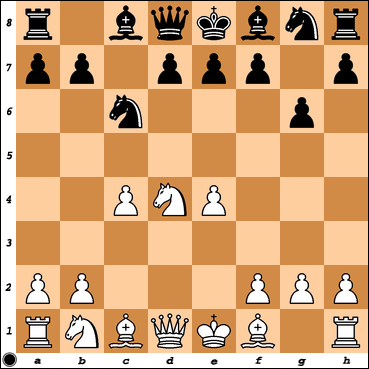
In Svehnikov black forces action in the center and accepts weaker d5. To this square white will try to settle a knight or a bishop. Often in this line white plays Bc1-g5xf6 to further weaken Black's grip on d5. Black can then develop counterplay on the dark squares.
The Sveshnikov and weak d5 square for black:
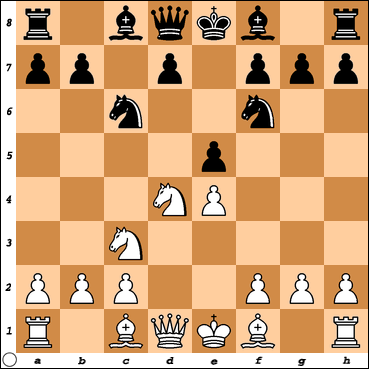
The Taimanov Sicilian is described by John Donaldson on book review on JeremySilman.com to be one of the most flexible variations in sicilian and is considered quite sound and reliable.
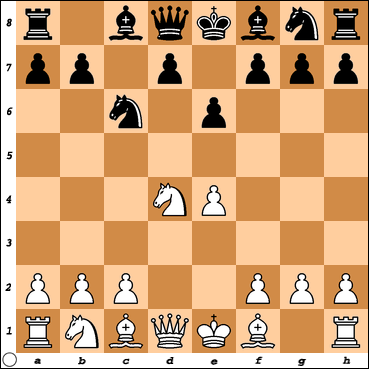
So. Kalashnikov. One of the ideas behind it is that after 4...e5 5.Nb5 d6 white does not have pin with Bg5.
Kalashnikov after 4...e5 5.Nb5 d6:

But anyway back to the position after 4.Nxd4 where none of this happened:

My opponent played 4...Nxd4?
Curiously I found Dan Heisman talking about this move in a column he wrote for ChessCafe.com. It violates couple of very basic principles, it helps white develop another piece, it wastes one tempo moving same piece twice and so slows down blacks development at the same time as it accelerates whites.
5.Qxd4 e6 6.Nc3
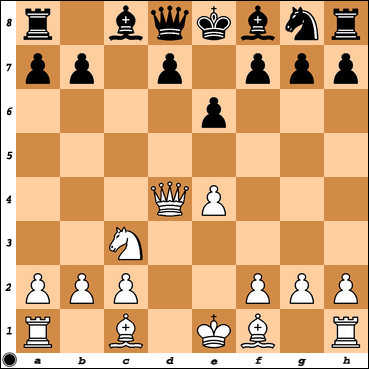
So. Black has one pawn developed and white has three pieces out. In theory white is one move away from castling to either side. Black is two moves away. On Chessbase.coms databases black has two main moves ...a6 and ...Ne7 that have both played around 30 times. The close seconds are ...b6 and ...d7 that have been played around 10 times. ...Nf6 was played by near 2400 rating player Evarth Kahn who managed to draw against Denis Sallinikov a near 2300 player.
The strongest player on my database with known ranking who has played the position is Igor Mikhailovich Khrenov who was there twice a bit over rating 2400. He played ...Ne7.
I left my Rybka 2.32a 32-bit calculating and also it did come up with two moves where it considers at the depth of 21 and 22 white to be only slightly better: ...Ne7 and ...a6.
So I guess ...Ne7 is pretty strong. The lines that arise with quick look are quite even with slight plus for white.
For example:
6...Ne7 7.Nb5 Nc6 8.Nd6+ Bxd6 9.Qxd6 Qe7 10.Qxe7+ Kxe7 11.b3 d6 12.c3 Rd8 13.Be3 b3 14.0-0-0
With unclear position where white might be slightly better:
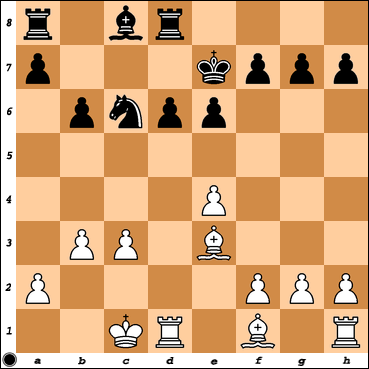
But anyway. This is after all 20 minute blitz game so I guess my opponent with almost 200 higher rating wanted to sharpen the position and chose:
6...Qc7?
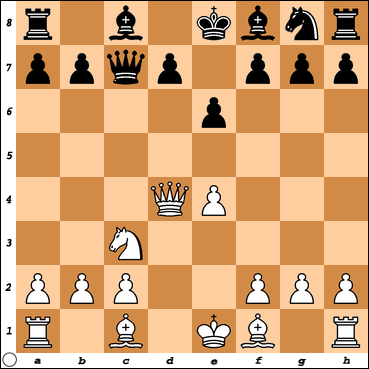
Rybka at the depth of 13 ranks this as 20th best move in the position and thinks that after this white is better by +1.38. I'm not sure what this accomplishes but expose queen for harrasment. This does nothing to help black castle it does not develop any of blacks minor pieces or better pawn structure. And now after black's sixth move white is much better if not winning!
And so I and my fellow chessfanatic Fischer played the excellent and only 7.Nb5!
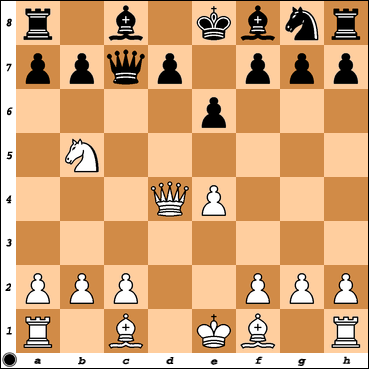
Funnilly enough in a game Steinar Hardersen - Amund Nergaard resigned at this point. It does not come easy to black from this position to do anything. Especially as we are in blitz game and black has feeling that the brilliancy of previous move should become apparent rather sooner then later.
The best move seems to be Qb8!
The position is just terrible but white still needs some good moves before anything should happen. It is just mentally very difficult to submit to this move.
For instance:
7...Qb8! 8.Qc3 Kd8 9.g3 f6 10.Bf4 e5 11.Be3 Nh6 12.Be2 b6 13.0-0 a6 14.Na3
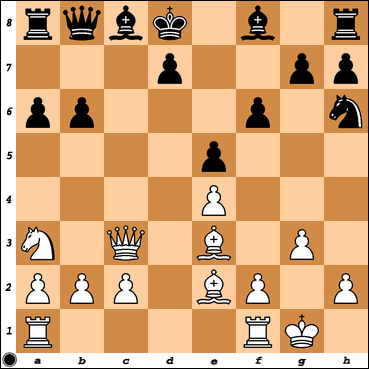
So. I can understand my opponent choosing Qxc2. And here is where I believe I outplayed Fischer.
Not many such occassions arise in my chess career so I proudly give you:
8.Bd3!
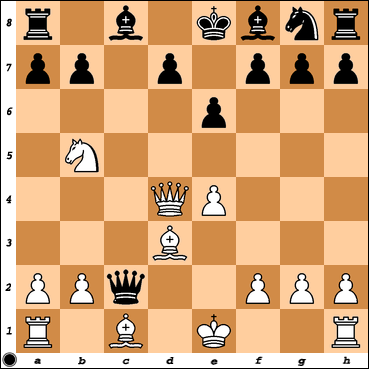
Naturally this is good not only because this develops yet another piece but also this puts black queen on a difficult spot. There is nowhere to go but Qc6 and black spends yet another tempo without anything concrete to show that is achieved. Nb5 knight looks hungrily for spot in c7 to fork rook and king all the time.
Fischer played 8.Bf4? and his opponent replied with excellent ...Bc5!
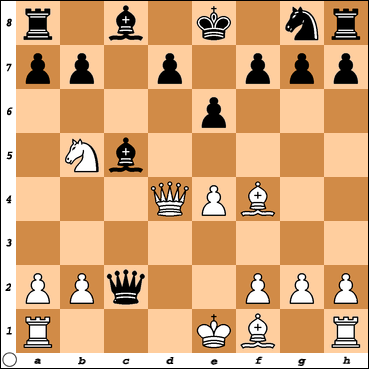
Suddenly white is only slightly better. Whites best take on the situation which Fischer also took is to go to 9.Qd2 let his opponent have e4 pawn by 9...Qxe4+.
Here Fischer essentially has lost the momentum but gets it back later even the game continued 10.Be2 Bb4 11.Nd6+ 12.Bxd6
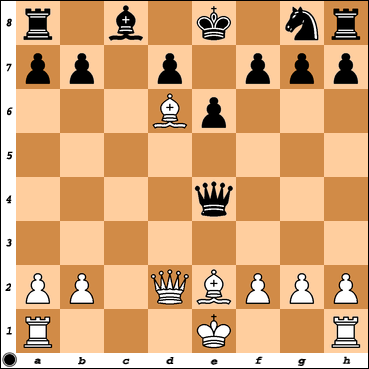
Here black has iniative and queen on central position ready to grab g2 pawn for starters and then better his position. But here Tordion played unenergetically and Fischer played more accurately and eventually equalized and got better of his opponent. If Fischer is not loosing the position it is easy to see it is complicated and far from where I got with my Bd3!

8...Qc6 9.Bf4!
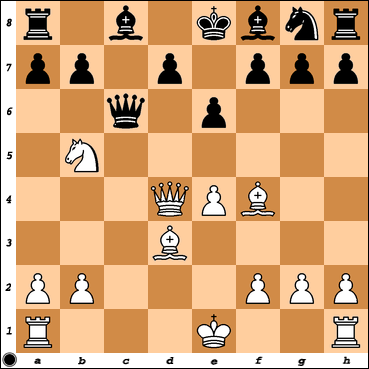
I develop yet another piece and have really strong spot on e7 where I still threaten to fork.
Here white still has a long way to go. The best reply from black would have probably been 9...f6.
For instance:
9..f6 10.Nc7+ Kd8 11.Nxa8 b6 12.Nxb6 axb6 13.Rc1 Bc5 14.Qc3 e5 15.Be3 Bxe3 16.fxe3
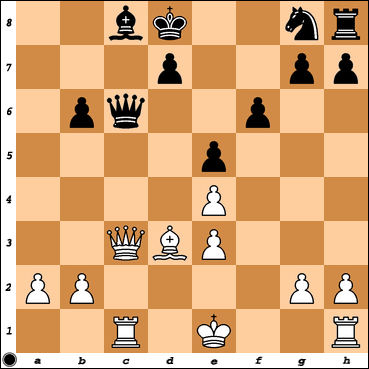
White is the exchange knight for a rook better but position is unclear and there is work and effort required to acquire the victory.
Black might want to exchange queens and white to develop his b-pawn and double his rooks. For instance:
16...Qxc3+ 17.Rxc3 Bb7 18.Ke2 Ne7 19.Rd1 Bc6 20.b4 Nc8 21.b5 Ba8 22.Bc4 Ke7 23.Rcd3
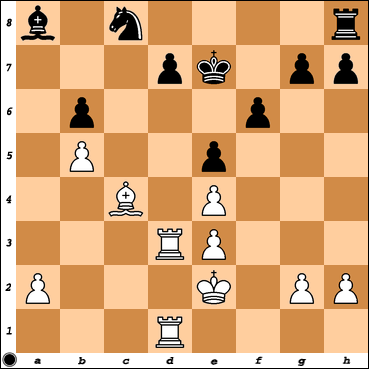
But. Here my opponent thought about position about two minutes, did not come with anything better, stumbled and played the aggressive looking but uninspired Bc5?
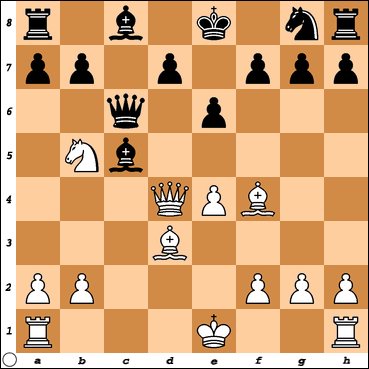
It is a loosing move at least in this game. He hungs his g pawn and eventually rook:
10.Qxg7! Bb4+ 11.Ke2!
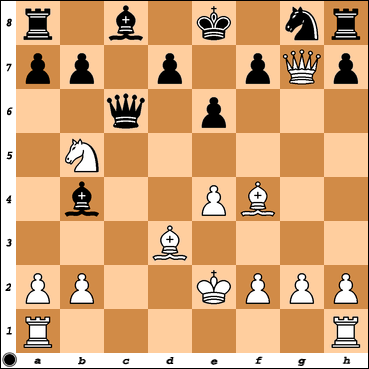
Here black resigned.
One possible line would have been:
11..e5 12.Bxe5 Qh6 13.Nc7+ Kd8 4.Qxh8 Qd2+ 15.Kf1 Qxd3+ 16.Kg1 d6 17.Nxa8
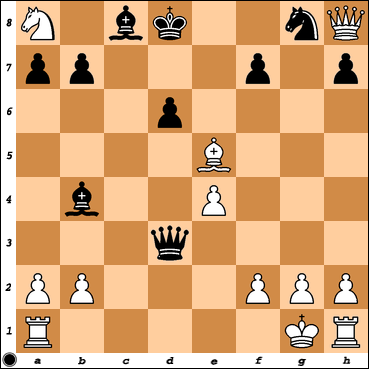
Pictoresque position that tells lot about my current concept of the game. I have startered to wonder how much using Rybka has influenced my game. I guess it is somewhat. I don't think positionally but I think in material and in tactics.
Black queen is in the middle influencing the game and all my pieces but bishop are close to edges. Both sides have open warfare where shots are given and taken. It is more about exchanging, tactics then long term strategy.
Me - NN
Blitz 20 minutes
28.5.2008
1.e4 c5 2.Nf3 Nc6 6.3.d4 9.cxd4 4.Nxd4

Here black has three standard approaches the Accelerated dragon 4...g6, the Sveshnikov variation which seems to be the main line 4...Nf6 5.Nc3 e5, 4...e6 that is the Taimanov Sicilian and the Kalishnikov Variation 4...e5.
At least on databases accelerated variation seems to favour white. One of the ideas behind it is to put pressure on d4 but at the same time allows white to set up the Maroczy Bind with c4.
Accelerated dragon and Maroczy Bind:

In Svehnikov black forces action in the center and accepts weaker d5. To this square white will try to settle a knight or a bishop. Often in this line white plays Bc1-g5xf6 to further weaken Black's grip on d5. Black can then develop counterplay on the dark squares.
The Sveshnikov and weak d5 square for black:

The Taimanov Sicilian is described by John Donaldson on book review on JeremySilman.com to be one of the most flexible variations in sicilian and is considered quite sound and reliable.

So. Kalashnikov. One of the ideas behind it is that after 4...e5 5.Nb5 d6 white does not have pin with Bg5.
Kalashnikov after 4...e5 5.Nb5 d6:

But anyway back to the position after 4.Nxd4 where none of this happened:

My opponent played 4...Nxd4?
Curiously I found Dan Heisman talking about this move in a column he wrote for ChessCafe.com. It violates couple of very basic principles, it helps white develop another piece, it wastes one tempo moving same piece twice and so slows down blacks development at the same time as it accelerates whites.
5.Qxd4 e6 6.Nc3

So. Black has one pawn developed and white has three pieces out. In theory white is one move away from castling to either side. Black is two moves away. On Chessbase.coms databases black has two main moves ...a6 and ...Ne7 that have both played around 30 times. The close seconds are ...b6 and ...d7 that have been played around 10 times. ...Nf6 was played by near 2400 rating player Evarth Kahn who managed to draw against Denis Sallinikov a near 2300 player.
The strongest player on my database with known ranking who has played the position is Igor Mikhailovich Khrenov who was there twice a bit over rating 2400. He played ...Ne7.
I left my Rybka 2.32a 32-bit calculating and also it did come up with two moves where it considers at the depth of 21 and 22 white to be only slightly better: ...Ne7 and ...a6.
So I guess ...Ne7 is pretty strong. The lines that arise with quick look are quite even with slight plus for white.
For example:
6...Ne7 7.Nb5 Nc6 8.Nd6+ Bxd6 9.Qxd6 Qe7 10.Qxe7+ Kxe7 11.b3 d6 12.c3 Rd8 13.Be3 b3 14.0-0-0
With unclear position where white might be slightly better:

But anyway. This is after all 20 minute blitz game so I guess my opponent with almost 200 higher rating wanted to sharpen the position and chose:
6...Qc7?

Rybka at the depth of 13 ranks this as 20th best move in the position and thinks that after this white is better by +1.38. I'm not sure what this accomplishes but expose queen for harrasment. This does nothing to help black castle it does not develop any of blacks minor pieces or better pawn structure. And now after black's sixth move white is much better if not winning!
And so I and my fellow chessfanatic Fischer played the excellent and only 7.Nb5!

Funnilly enough in a game Steinar Hardersen - Amund Nergaard resigned at this point. It does not come easy to black from this position to do anything. Especially as we are in blitz game and black has feeling that the brilliancy of previous move should become apparent rather sooner then later.
The best move seems to be Qb8!
The position is just terrible but white still needs some good moves before anything should happen. It is just mentally very difficult to submit to this move.
For instance:
7...Qb8! 8.Qc3 Kd8 9.g3 f6 10.Bf4 e5 11.Be3 Nh6 12.Be2 b6 13.0-0 a6 14.Na3

So. I can understand my opponent choosing Qxc2. And here is where I believe I outplayed Fischer.
Not many such occassions arise in my chess career so I proudly give you:
8.Bd3!

Naturally this is good not only because this develops yet another piece but also this puts black queen on a difficult spot. There is nowhere to go but Qc6 and black spends yet another tempo without anything concrete to show that is achieved. Nb5 knight looks hungrily for spot in c7 to fork rook and king all the time.
Fischer played 8.Bf4? and his opponent replied with excellent ...Bc5!

Suddenly white is only slightly better. Whites best take on the situation which Fischer also took is to go to 9.Qd2 let his opponent have e4 pawn by 9...Qxe4+.
Here Fischer essentially has lost the momentum but gets it back later even the game continued 10.Be2 Bb4 11.Nd6+ 12.Bxd6

Here black has iniative and queen on central position ready to grab g2 pawn for starters and then better his position. But here Tordion played unenergetically and Fischer played more accurately and eventually equalized and got better of his opponent. If Fischer is not loosing the position it is easy to see it is complicated and far from where I got with my Bd3!

8...Qc6 9.Bf4!

I develop yet another piece and have really strong spot on e7 where I still threaten to fork.
Here white still has a long way to go. The best reply from black would have probably been 9...f6.
For instance:
9..f6 10.Nc7+ Kd8 11.Nxa8 b6 12.Nxb6 axb6 13.Rc1 Bc5 14.Qc3 e5 15.Be3 Bxe3 16.fxe3

White is the exchange knight for a rook better but position is unclear and there is work and effort required to acquire the victory.
Black might want to exchange queens and white to develop his b-pawn and double his rooks. For instance:
16...Qxc3+ 17.Rxc3 Bb7 18.Ke2 Ne7 19.Rd1 Bc6 20.b4 Nc8 21.b5 Ba8 22.Bc4 Ke7 23.Rcd3

But. Here my opponent thought about position about two minutes, did not come with anything better, stumbled and played the aggressive looking but uninspired Bc5?

It is a loosing move at least in this game. He hungs his g pawn and eventually rook:
10.Qxg7! Bb4+ 11.Ke2!

Here black resigned.
One possible line would have been:
11..e5 12.Bxe5 Qh6 13.Nc7+ Kd8 4.Qxh8 Qd2+ 15.Kf1 Qxd3+ 16.Kg1 d6 17.Nxa8

Pictoresque position that tells lot about my current concept of the game. I have startered to wonder how much using Rybka has influenced my game. I guess it is somewhat. I don't think positionally but I think in material and in tactics.
Black queen is in the middle influencing the game and all my pieces but bishop are close to edges. Both sides have open warfare where shots are given and taken. It is more about exchanging, tactics then long term strategy.
Wednesday, 28 May 2008
...but I just didn't see it?
My game on FICS this morning had couple of knocks and turns but in the end I missed a mate which would have resulted on defeat or draw if my opponent would have been more careful.
My theory goes if I try to verbalise the ideas - maybe next time instead of my mind going blank I would maybe recollect the idea.
The thing was I was short on time. I was trying to calculate and did saw two halfmoves ahead but failed to asses the position after that.
My opponent was clearly better and fumbled with 27.g3??
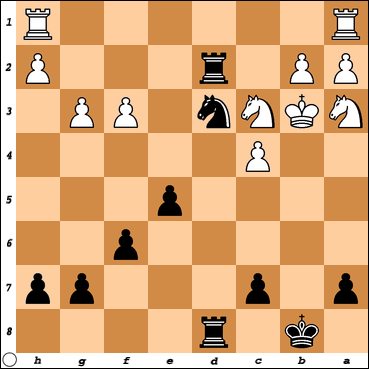
I did found 27...Rxb2!
White king has nowhere else to go to but 28.Ka4.
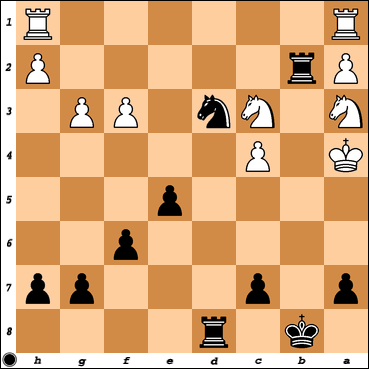
Here I spent three minutes and 17 seconds from 20 minutes I had for all for these moves and now I was running on few minutes.
In my mind I did see 28...Nc5+ 29.Ka4
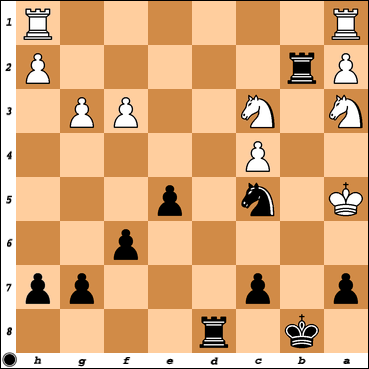
But then I did not see the next move. I gathered I need another rook.
All in all I did not succeed to visualize where I could mate exactly and how did I could mate.
So.
29...Rd6 and white has nothing to prevent 30...Ra6#
So I saw Nc5+ but played 28...Ka8? and here the game is draw. Fortunately my opponent didn't pull it off.
I think I was trying to get my rook to a6 using four moves or rather get two rooks restricting white king.
I am not sure how to avoid such blank moments. Instead of vague idea I would need crystallized moves.
One thing is maybe have a mind fully working. I'm bit tired at the moment.
My theory goes if I try to verbalise the ideas - maybe next time instead of my mind going blank I would maybe recollect the idea.
The thing was I was short on time. I was trying to calculate and did saw two halfmoves ahead but failed to asses the position after that.
My opponent was clearly better and fumbled with 27.g3??

I did found 27...Rxb2!
White king has nowhere else to go to but 28.Ka4.

Here I spent three minutes and 17 seconds from 20 minutes I had for all for these moves and now I was running on few minutes.
In my mind I did see 28...Nc5+ 29.Ka4

But then I did not see the next move. I gathered I need another rook.
All in all I did not succeed to visualize where I could mate exactly and how did I could mate.
So.
29...Rd6 and white has nothing to prevent 30...Ra6#
So I saw Nc5+ but played 28...Ka8? and here the game is draw. Fortunately my opponent didn't pull it off.
I think I was trying to get my rook to a6 using four moves or rather get two rooks restricting white king.
I am not sure how to avoid such blank moments. Instead of vague idea I would need crystallized moves.
One thing is maybe have a mind fully working. I'm bit tired at the moment.
Subscribe to:
Posts (Atom)